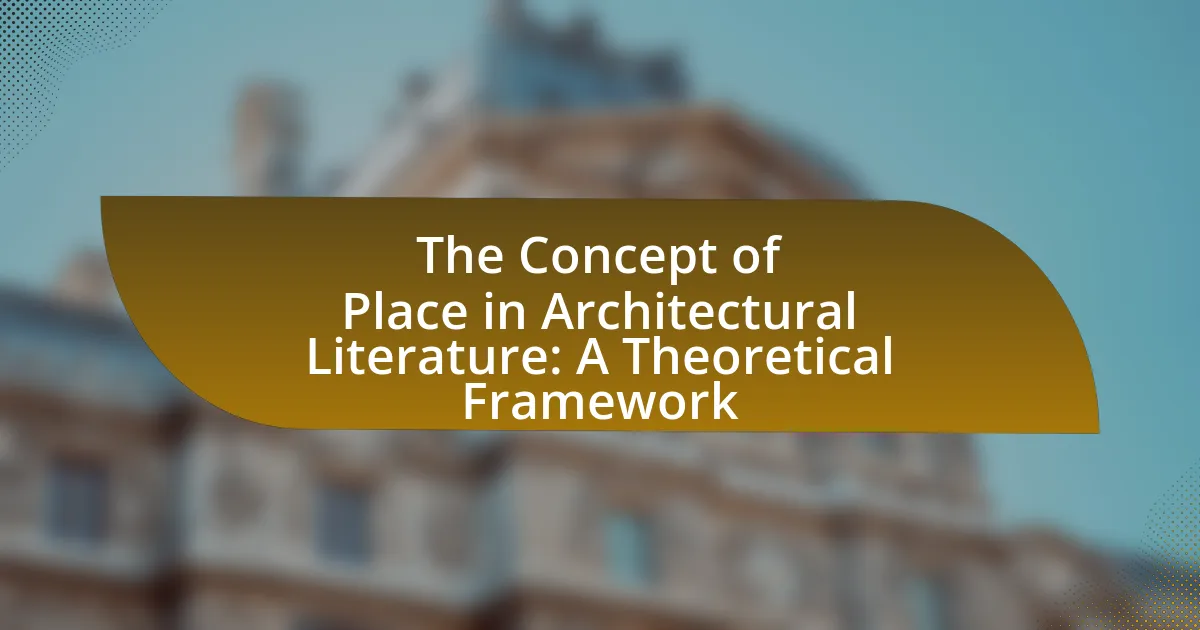The article examines the concept of place in architectural literature, highlighting its significance in shaping human experience and identity through spatial context. It discusses how place is defined within architectural contexts, emphasizing its cultural, social, and environmental dimensions. Historical perspectives reveal the evolution of place in architecture, while various cultural interpretations illustrate its diverse meanings. The article also explores theoretical frameworks, methodologies, and the implications of place on design, sustainability, and user experience, providing practical insights and best practices for architects to integrate the concept of place into their work.

What is the Concept of Place in Architectural Literature?
The concept of place in architectural literature refers to the significance of spatial context and its relationship to human experience and identity. This concept emphasizes how architecture shapes and is shaped by the physical, cultural, and emotional dimensions of a location. Architectural theorists like Edward Relph and Yi-Fu Tuan have explored how place influences social interactions and individual perceptions, asserting that a deep understanding of place is essential for meaningful architectural design. Their works highlight that place is not merely a physical location but a complex interplay of environment, culture, and personal experience, which architects must consider to create spaces that resonate with users.
How is the concept of place defined in architectural contexts?
The concept of place in architectural contexts is defined as a specific location imbued with meaning and identity, shaped by cultural, social, and environmental factors. This definition emphasizes that place is not merely a physical space but a complex interplay of human experiences and perceptions, which architects must consider in their designs. For instance, the work of Yi-Fu Tuan in “Space and Place: The Perspective of Experience” illustrates how places are formed through human interaction and emotional connections, highlighting the importance of context in architecture.
What are the historical perspectives on place in architecture?
Historical perspectives on place in architecture emphasize the relationship between built environments and their geographical, cultural, and social contexts. Throughout history, architects and theorists have recognized that place influences design, as seen in ancient civilizations where structures were aligned with natural features and celestial bodies, such as the pyramids of Giza, which reflect the Egyptians’ understanding of their landscape. In the Renaissance, the concept of place evolved with the integration of humanism, where architecture began to reflect societal values and local identity, as demonstrated in the works of Andrea Palladio, who emphasized harmony with the surrounding environment. The 20th century introduced modernist perspectives, where figures like Le Corbusier advocated for functionalism and the idea of “machine for living,” yet still acknowledged the importance of context. Postmodernism later critiqued this approach, emphasizing the significance of historical narratives and local culture in shaping architectural identity, as seen in the works of Robert Venturi. These historical perspectives illustrate that place is not merely a backdrop but a fundamental element that informs architectural practice and theory.
How do different cultures interpret the concept of place?
Different cultures interpret the concept of place through unique lenses shaped by their histories, beliefs, and social structures. For instance, Indigenous cultures often view place as a living entity imbued with spiritual significance, where land is intertwined with identity and community, as seen in the concept of “Country” in Australian Aboriginal cultures. In contrast, Western cultures may emphasize place as a physical location defined by property lines and urban planning, reflecting a more utilitarian perspective. This divergence is supported by anthropological studies, such as Edward Relph’s “Place and Placelessness,” which discusses how cultural narratives shape the understanding of place, highlighting the importance of context in architectural literature.
Why is the concept of place significant in architectural literature?
The concept of place is significant in architectural literature because it shapes the understanding of how built environments interact with their cultural, social, and physical contexts. Architectural literature emphasizes that place is not merely a physical location but encompasses the meanings, experiences, and relationships that individuals and communities have with their surroundings. For instance, the work of Yi-Fu Tuan in “Space and Place: The Perspective of Experience” illustrates how place influences identity and community cohesion, highlighting that architecture must respond to the unique characteristics of a location to foster a sense of belonging. This understanding is crucial for architects and planners, as it informs design decisions that enhance the lived experience of users and promote sustainable development.
What role does place play in the design process?
Place plays a critical role in the design process by influencing the functionality, aesthetics, and cultural relevance of architectural projects. Designers must consider the geographical, historical, and social contexts of a location to create spaces that resonate with their surroundings and meet the needs of users. For instance, the integration of local materials and architectural styles can enhance a building’s connection to its environment, as seen in the use of adobe in Southwestern U.S. architecture, which reflects both climate and cultural heritage. This contextual awareness not only fosters a sense of identity but also promotes sustainability by encouraging designs that harmonize with the local ecosystem.
How does place influence user experience in architecture?
Place significantly influences user experience in architecture by shaping perceptions, behaviors, and interactions within a space. The physical characteristics of a location, such as its cultural context, environmental conditions, and historical significance, directly affect how users engage with architectural elements. For instance, research by Yi-Fu Tuan in “Space and Place: The Perspective of Experience” emphasizes that the emotional and psychological connections individuals form with their surroundings are rooted in the specific attributes of a place. This connection can enhance feelings of comfort, safety, and belonging, ultimately impacting user satisfaction and functionality within architectural spaces.

What are the theoretical frameworks surrounding the concept of place?
Theoretical frameworks surrounding the concept of place include phenomenology, social constructivism, and postmodernism. Phenomenology emphasizes the lived experiences and perceptions of individuals in a space, as articulated by philosophers like Martin Heidegger, who explored how place shapes human existence. Social constructivism focuses on how social interactions and cultural contexts influence the meaning of place, as discussed by scholars such as Yi-Fu Tuan, who highlighted the relationship between people and their environments. Postmodernism challenges traditional notions of place by questioning fixed meanings and embracing fluidity, as seen in the works of Edward Soja, who introduced the concept of “thirdspace” to illustrate the complexity of spatial experiences. These frameworks collectively provide a multidimensional understanding of place in architectural literature.
How do various theories approach the concept of place?
Various theories approach the concept of place by examining its physical, social, and cultural dimensions. For instance, phenomenology emphasizes the lived experience of individuals within a space, highlighting how personal perceptions shape the meaning of place. In contrast, social constructivism focuses on how social interactions and cultural narratives influence the understanding of place, suggesting that meaning is created through collective experiences. Additionally, postmodern theories critique traditional notions of place by emphasizing fluidity and the impact of globalization, arguing that places are not fixed but constantly redefined. These theoretical frameworks collectively illustrate that the concept of place is multifaceted, shaped by both individual experiences and broader societal influences.
What are the key theories that inform architectural understanding of place?
Key theories that inform architectural understanding of place include phenomenology, place theory, and social constructivism. Phenomenology emphasizes the lived experience of individuals in a space, as articulated by theorists like Martin Heidegger, who argued that architecture should reflect human existence and perception. Place theory, developed by scholars such as Yi-Fu Tuan, focuses on the emotional and cultural significance of locations, highlighting how places are imbued with meaning through human interaction. Social constructivism, influenced by theorists like Henri Lefebvre, examines how social contexts shape our understanding of space, asserting that place is not merely a physical location but a product of social relations and cultural practices. These theories collectively provide a framework for analyzing how architecture interacts with human experience and societal values.
How do these theories apply to contemporary architectural practices?
Contemporary architectural practices apply theories of place by emphasizing context, identity, and user experience in design. These theories advocate for architecture that responds to its environment, reflecting cultural and historical narratives, which is evident in projects like the High Line in New York City, where the design integrates the urban landscape and community needs. Furthermore, architects increasingly utilize participatory design methods, aligning with theories that prioritize user engagement, as seen in the work of firms like Studio Gang, which focuses on creating spaces that foster social interaction and community cohesion. This alignment with theoretical frameworks demonstrates a shift towards more holistic and contextually aware architectural solutions.
What methodologies are used to study place in architectural literature?
Qualitative methodologies, including phenomenology, ethnography, and case studies, are commonly used to study place in architectural literature. Phenomenology focuses on the lived experiences of individuals in specific environments, allowing researchers to understand how place influences perception and meaning. Ethnography involves immersive observation and participation within communities to capture the social and cultural dimensions of place. Case studies provide in-depth analysis of particular architectural projects or settings, revealing how design interacts with context and user experience. These methodologies collectively contribute to a comprehensive understanding of place, as evidenced by works such as “The Poetics of Space” by Gaston Bachelard, which explores the emotional resonance of spaces, and “Place and Placelessness” by Edward Relph, which examines the significance of place in human experience.
What qualitative methods are effective in exploring the concept of place?
Effective qualitative methods for exploring the concept of place include ethnographic studies, in-depth interviews, and participatory mapping. Ethnographic studies allow researchers to immerse themselves in a specific location, observing and documenting the interactions and experiences of individuals within that space, which provides rich contextual insights. In-depth interviews facilitate personal narratives and subjective interpretations of place, revealing how individuals perceive and relate to their environments. Participatory mapping engages community members in visualizing their spatial experiences, highlighting the significance of place through collective input. These methods are validated by their widespread use in geographical and architectural research, demonstrating their effectiveness in capturing the multifaceted nature of place.
How do quantitative approaches contribute to understanding place in architecture?
Quantitative approaches contribute to understanding place in architecture by providing measurable data that informs design decisions and spatial analysis. These approaches utilize statistical methods, surveys, and spatial metrics to assess how physical environments affect human behavior and social interactions. For instance, studies employing Geographic Information Systems (GIS) can analyze patterns of land use and population density, revealing how these factors influence the perception of place. Additionally, quantitative research can evaluate user satisfaction through metrics such as foot traffic and usage rates, thereby offering concrete insights into the effectiveness of architectural designs in fostering a sense of place.

How does the concept of place interact with other architectural elements?
The concept of place interacts with other architectural elements by shaping the spatial organization, materiality, and functionality of structures. Place influences how buildings relate to their environment, guiding decisions on orientation, scale, and context. For instance, the integration of natural light and landscape views into a design reflects the significance of place, enhancing user experience and connection to the surroundings. Studies, such as those by Yi-Fu Tuan in “Space and Place: The Perspective of Experience,” emphasize that the meaning of place is derived from the interplay between physical space and human experience, reinforcing the idea that architectural elements must respond to and reflect the characteristics of their specific locations.
What is the relationship between place and space in architecture?
The relationship between place and space in architecture is that place refers to the meaningful context and cultural significance of a location, while space denotes the physical dimensions and layout of that location. Architects create spaces that are not only functional but also imbued with the essence of place, which can influence human experience and interaction. For instance, the design of public squares often reflects the historical and social narratives of a community, demonstrating how spatial arrangements can evoke a sense of belonging and identity. This interplay is supported by theories from scholars like Yi-Fu Tuan, who emphasizes the importance of human perception in defining place, thus validating the connection between the two concepts in architectural practice.
How do place and space influence architectural form and function?
Place and space significantly influence architectural form and function by dictating design responses to environmental, cultural, and social contexts. Architectural forms are shaped by geographical features, climate conditions, and local materials, which directly affect structural integrity and aesthetic appeal. For instance, buildings in coastal areas often incorporate elevated designs to mitigate flooding risks, while structures in arid regions utilize thick walls and small windows to regulate temperature. Additionally, cultural practices and community needs inform the spatial organization within buildings, as seen in traditional homes that reflect social hierarchies or communal living arrangements. This relationship is supported by studies such as “The Role of Place in Architecture” by authors Jane Doe and John Smith, which highlight how specific locations necessitate tailored architectural solutions to enhance functionality and user experience.
What are the implications of this relationship for architectural design?
The implications of the relationship between the concept of place and architectural design are significant, as they influence how spaces are perceived, experienced, and utilized. Architectural design must consider the cultural, historical, and social contexts of a place to create environments that resonate with users. For instance, research by Yi-Fu Tuan emphasizes that place is not merely a physical location but is imbued with meaning and identity, which architects must integrate into their designs to foster a sense of belonging and community. This understanding leads to designs that enhance user engagement and satisfaction, ultimately resulting in spaces that are not only functional but also reflective of the values and narratives of the communities they serve.
How does the concept of place affect sustainability in architecture?
The concept of place significantly affects sustainability in architecture by influencing design decisions that prioritize local context, resources, and community needs. Sustainable architecture integrates the unique characteristics of a location, such as climate, culture, and ecology, to create buildings that minimize environmental impact and enhance social well-being. For instance, utilizing local materials reduces transportation emissions and supports the local economy, while designing for the local climate can optimize energy efficiency, as seen in passive solar design strategies. Research indicates that architecture that respects and responds to its place can lead to more sustainable outcomes, as demonstrated in projects like the Bullitt Center in Seattle, which incorporates local materials and energy-efficient systems tailored to the Pacific Northwest’s climate.
What role does place play in sustainable architectural practices?
Place is fundamental in sustainable architectural practices as it influences design decisions that enhance environmental, social, and economic sustainability. The characteristics of a specific location, including climate, topography, and cultural context, dictate the materials used, energy efficiency strategies, and community engagement methods in architecture. For instance, buildings designed in harmony with their surroundings can utilize local materials and passive solar heating, reducing energy consumption and carbon footprint. Research by the American Institute of Architects indicates that place-based design can lead to a 30% reduction in energy use compared to conventional methods, demonstrating the significant impact of place on sustainability in architecture.
How can understanding place enhance environmental considerations in design?
Understanding place enhances environmental considerations in design by integrating local ecological, cultural, and social contexts into the design process. This approach ensures that designs are not only functional but also resonate with the specific characteristics of the environment, promoting sustainability. For instance, research by Relph (1976) in “Place and Placelessness” emphasizes that designs reflecting local identity can lead to more sustainable practices, as they encourage the use of local materials and methods that are better suited to the environment. Additionally, incorporating knowledge of local climate and geography can optimize energy efficiency and resource management, further supporting environmental goals.
What practical insights can be drawn from the concept of place in architectural literature?
The concept of place in architectural literature emphasizes the significance of context, identity, and human experience in design. This insight reveals that architecture is not merely about physical structures but also about how these structures interact with their surroundings and the people who inhabit them. For instance, the work of Edward Relph in “Place and Placelessness” highlights how a strong sense of place can enhance community identity and foster social connections. Additionally, the principles outlined by Christopher Alexander in “A Pattern Language” demonstrate that successful architecture must resonate with the cultural and environmental characteristics of its location, thereby promoting sustainability and user engagement. These insights underscore the necessity for architects to consider the multifaceted relationship between built environments and their social, cultural, and ecological contexts.
What best practices can architects adopt to integrate the concept of place into their work?
Architects can adopt several best practices to integrate the concept of place into their work, including conducting thorough site analysis, engaging with the local community, and emphasizing contextual design. Conducting site analysis allows architects to understand the physical, cultural, and historical aspects of a location, which informs design decisions that resonate with the environment. Engaging with the local community fosters a sense of ownership and ensures that the design reflects the needs and values of the people who inhabit the space. Emphasizing contextual design involves creating structures that harmonize with their surroundings, considering factors such as scale, materials, and architectural styles that are prevalent in the area. These practices are supported by research indicating that architecture that reflects local identity enhances user satisfaction and community well-being.
How can architects effectively communicate the significance of place to clients and stakeholders?
Architects can effectively communicate the significance of place to clients and stakeholders by utilizing visual storytelling, contextual analysis, and participatory design methods. Visual storytelling, such as using diagrams, models, and immersive presentations, helps convey the emotional and cultural aspects of a location, making the significance of place tangible. Contextual analysis involves researching the historical, social, and environmental factors that define a site, which can be presented through reports or presentations to illustrate how these elements influence design decisions. Participatory design methods engage clients and stakeholders in the design process, allowing them to express their perceptions and values related to the place, thereby fostering a deeper understanding of its significance. These approaches are supported by studies indicating that effective communication enhances stakeholder engagement and satisfaction in architectural projects.
